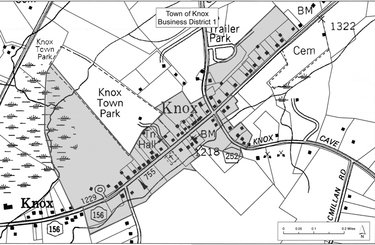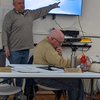Planning board draws the line
KNOX — The planning board finalized lines last Thursday that would designate Knox’s first business district if the town board approves the plan after a public hearing this spring.
The gallery was empty for the half-hour session as discussion of a second, controversial business district had been struck from the agenda.
“I have to be careful what I say, but we don’t need to discuss it tonight,” Robert Price, the planning board chairman, said when member Daniel Driscoll asked why zoning board members weren’t at the meeting as planned.
“My goal is to settle the boundaries in Business District 1,” said Price at the start of the meeting.
The board had agreed earlier to remove the town park from the proposed district.
The map that board members pored over delineates a district that runs on either side of Route 156 for the length of the hamlet.
Knox had long had a de facto business district in the hamlet that once included a gas station, post office, and general store but, as these businesses closed, new ones wouldn’t legally be allowed to open without a change in the zoning law. Those businesses were all clustered at one end of the hamlet.
The matter became an issue in last November’s town elections with candidates on both sides talking about the need for a business district.
Knox’s comprehensive land-use plan, which was created in 1994 to guide decision-making, is currently being revamped. The 1994 plan mentions the hamlet as a possible location for a business district.
Vasilios Lefkaditis, a Knox resident who serves on the school board, has purchased property in the hamlet that includes the defunct general store and the post office, which was forced to close a year ago when vermin and mold were found in the building.
Lefkaditis wants to lease the buildings to businesses and first broached the matter with the planning board last March.
Driscoll, who helped draft the 1994 master plan, said at last Thursday’s meeting that the plan points out the business district doesn’t have public water or sewage systems and says, for that reason, it should be a small one. In the future, if businesses are built, the town may need to provide public systems as the town of Berne is currently doing for its hamlet, he said.
Alluding to the karst topography that underlies the hamlet, Price, who also worked on the master plan, said that water poured out on the ground around Route 156 would end up in “everybody’s wells.”
After considerable back-and-forth discussion, much of it focusing on particular parcel lines, the board agreed the cemetery towards the center of the hamlet will be included in the district, not to be built upon but rather for ease of defining the district, and that lots that are served by the lighting district will also be included in the business district.
Price commended board member Betty Ketcham for drawing up a map and said, “Let’s task Betty and Dan to get together over a bottle of 20-year-old scotch” to complete the changes agreed upon for the map.
Finally, Price asked if the proposed district should officially be called “Business District 1” or “Business District.”
“I call for simplicity,” began board member Robert Gwin.
Price, however, said he was “strongly in favor” of “Business District 1” to which most of the others agreed.
Price concluded the meeting by announcing that on Jan. 25, at the annual Winterfest, “Yours truly will make another attempt to win the cook-off.” His chili, Price said, has been awarded second place “over and over again.”



